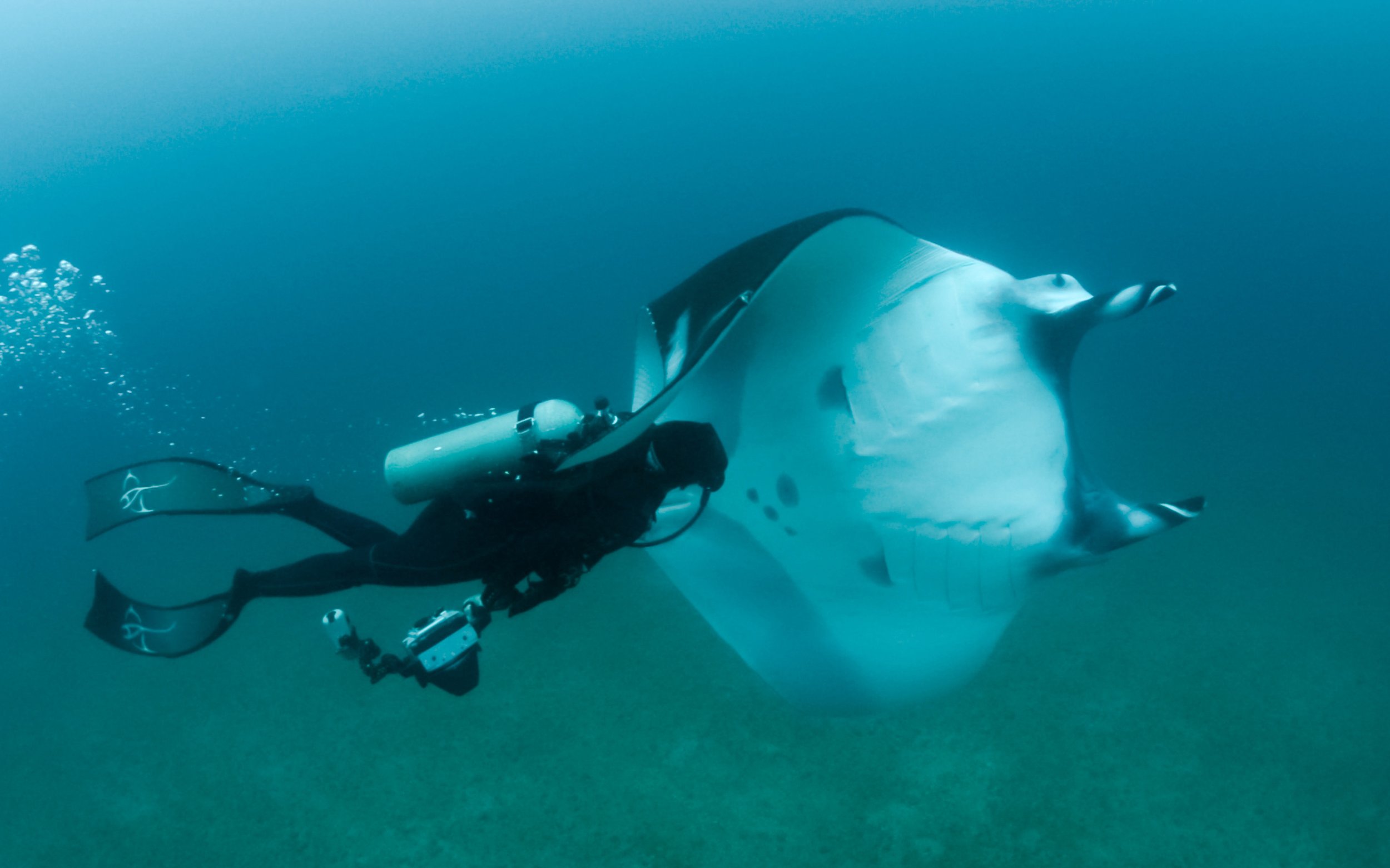New Study Finds The World's Largest Population Of Giant Oceanic Manta Rays
The 14-year study identified more than 2,800 individual giant manta rays in Ecuador- more than any other study to date.
The large numbers of giant oceanic manta rays seasonally aggregate in the area to feed along Ecuador’s productive coastline, with concurrent studies in the region by MMF researchers suggesting they feed on meso-pelagic zooplankton.
Individuals may be drawn to offshore islands and seamounts near to their foraging grounds in large numbers to clean, socialize and even find mates.
Population modeling suggests the overall population of giant oceanic manta rays in Ecuador and Peru to be the largest in the world, with estimates of over 22,000 individuals.
Andrea with a friendly giant oceanic manta
New collaborative research by the Marine Megafauna Foundation, the Marine Megafauna Foundation Ecuador, and the Manta Trust on giant oceanic manta rays off the Ecuadorian coast has definitively identified more individuals than any other location in the world, with over 2,800 identified during the 14-year study period. MMF principal scientist Dr. Andrea Marshall, who oversaw the project for several years, says:
"Ecuador is hands down one of the most exciting places to dive with and research giant oceanic manta rays in the world.
Interacting with massive 6m+ individuals is extraordinary, and the sheer number of individuals that seasonally aggregate off the mainland is mind-blowing. There were days we were swimming with dozens of them at a time – one of the privileges of my research career."
The long-term research program focused on describing the size and composition of this vital population, learning more about their feeding ecology, and examining their movement patterns in the region. For several years, various members of the MMF team contributed to intensive seasonal fieldwork. The team included MMF biologist Katherine Burgess who completed a successful Ph.D. thesis and was awarded her doctorate for her efforts from the University of Queensland.
None of the team members, including Giles Winstanley, who managed the database during their time in Ecuador, expected at the outset that this would become the largest identified population on record in the world. "It gives us a ray of hope for a species which is now globally endangered with extinction," says Marshall. "As other giant oceanic manta ray populations worldwide dwindle, it is encouraging to see the sheer numbers in this region.”
A giant oceanic manta getting friendly with our photo identification team off the coast of Ecuador.
Copyright: Andrea Marshall
The prevalence of fishing line entanglements
Sadly, the study surfaced an alarming finding– over 500 individuals showed human-induced scarring, mainly from nets or fishing line entanglement – highlighting a significant threat from fishing in the region. Andrea details harrowing accounts of rescues during her time there:
"I was shocked to see how prevalent entanglements were in the region. Every year we would spend dive after dive removing fishing lines, hooks, and, worst case, large fishing nets from the mantas.
Some of the mantas were so badly entangled with heavily fouled nets that the lines would embed into their skin, making rescue extremely difficult and dangerous. There were times I would find myself hooked and entangled myself as I tried to rescue the mantas, and I constantly worried about getting pulled into the depths once connected to the mantas and the lines.
Our team members could spend entire dives cutting away at the nets and lines- the mantas patiently cooperating, remaining calm, barely swimming, the whole time. These encounters always reminded us how intelligent these animals truly are.
Some entangled mantas would swim directly to us as if to solicit assistance.
These were surreal moments for us.”
Andrea freeing a manta from heavy fishing lines
Many rescues were bittersweet for Andrea and her husband, Janneman Conradie, who was also a long-term member of the project.
“There were far too many occasions after a rescue when badly injured or emaciated mantas swam away, and we were not sure if our efforts were enough to save them. It was heartbreaking but also gratifying work. As conservation biologists, we can't always physically see or experience the impact we are having. Rescues allow us to feel immediate satisfaction, knowing that our actions made the future for that specific manta brighter.”
Protecting giant oceanic manta rays
The high incidence of entanglements and prevalence of unnatural injuries on the manta rays in this region underscores fishing as a significant threat to this species, which needs to be addressed by any future management plan. Giant oceanic mantas became a protected species in Ecuador in 2010. Already, expansions and better protection of their critical habitats are underway.
Andrea being interviewed at CMS COP 11
Andrea and the MMF team were proud to work with the Ecuadorian government to help champion the listing of giant mantas on the Convention for Migratory Species (CMS). This listing encourages increased conservation of this species which undertakes sizable migrations and regularly moves into international waters.
"Our team works on manta rays across the globe, but we have a special place in our heart for the Ecuadorian population. We feel incredibly privileged to have helped spearhead manta research in the region and then play a pivotal role in their conservation.
Having an impact like this and feeling like you can make a difference is why we got into this line of work. I will always be grateful for the time I spent in Ecuador.”
END
Notes to Editors:
For questions about this press release, please contact:
Dr. Andrea Marshall – Co-founder, Marine Megafauna Foundation
The Marine Megafauna Foundation (MMF) was created in 2009 to research, protect, and conserve the populations of threatened marine megafauna around the world. MMF’s headquarters are located in Tofo, Mozambique, where they operate as Associação Megafauna Marinha (AMM). ‘Megafauna’ are large species such as sharks, rays, and sea turtles. For further details, please visit www.marinemegafauna.org or follow us on Twitter, Facebook, Instagram, and LinkedIn.














